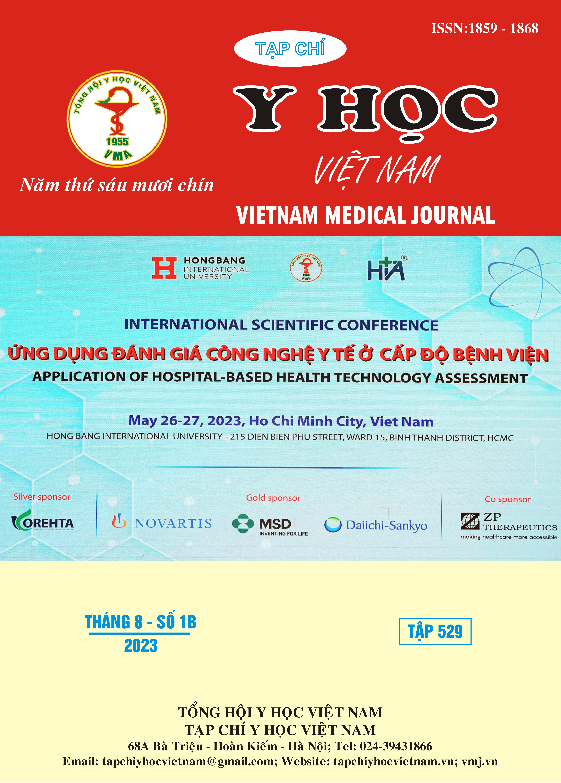ĐÁNH GIÁ ÁP LỰC CƠ THẮT THỰC QUẢN DƯỚI VÀ NHU ĐỘNG THỰC QUẢN Ở BỆNH NHÂN ĐÁI THÁO ĐƯỜNG TYPE 2 CÓ TRIỆU CHỨNG TRÀO NGƯỢC
Nội dung chính của bài viết
Tóm tắt
Mục tiêu: Khảo sát đặc điểm áp lực cơ thắt thực quản dưới và nhu động thực quản bằng kĩ thuật đo HRM ở bệnh nhân đái tháo đường (ĐTĐ) type 2 có triệu chứng trào ngược dạ dày – thực quản. Đối tượng: 62 bệnh nhân có triệu chứng trào ngược dạ dày – thực quản (trong đó 31 bệnh nhân ĐTĐ type 2 và 31 bệnh nhân không mắc ĐTĐ). Kết quả: Áp lực cơ thắt thực quản trên (UES), áp lực trung bình khi nghỉ của cơ thắt thực quản dưới (LES) và áp lực tích hợp khi nghỉ trong 4 giây của LES (IRP4s) ở bệnh nhân ĐTĐ type 2 thấp hơn đáng kể so với bệnh nhân không mắc ĐTĐ (p<0,05). Tỷ lệ rối loạn nhu động thực quản ở nhóm bệnh nhân ĐTĐ type 2 (71,0%) cao hơn có ý nghĩa so với nhóm bệnh nhân không mắc ĐTĐ (41,9%) (p<0,05). Trong các bệnh nhân ĐTĐ type 2, những bệnh nhân có chỉ số HbA1c ≥ 7% có áp lực LES khi nghỉ và IRP4s thấp hơn so với nhóm bệnh nhân HbA1c < 7% (p<0,05). Kết luận: Ở các bệnh nhân có triệu chứng trào ngược dạ dày – thực quản, tỷ lệ rối loạn nhu động thực quản ở nhóm bệnh nhân ĐTĐ type 2 cao hơn so với nhóm bệnh nhân không ĐTĐ. Áp lực UES, áp lực LES lúc nghỉ, IRP4s ở nhóm bệnh nhân ĐTĐ type 2 thấp hơn so với nhóm bệnh nhân không mắc ĐTĐ
Chi tiết bài viết
Từ khóa
Trào ngược dạ dày – thực quản, đo áp lực và nhu động thực quản (HRM), đái tháo đường, cơ thắt thực quản dưới (LES), áp lực tích hợp khi nghỉ (IRP4s)
Tài liệu tham khảo
2. Relationships of Upper Gastrointestinal Motor and Sensory Function With Glycemic Control | Diabetes Care | American Diabetes Association. Accessed June 13, 2022.
3. Fox MR, Sweis R, Yadlapati R, et al. Chicago classification version 4.0© technical review: Update on standard high-resolution manometry protocol for the assessment of esophageal motility. Neurogastroenterol Motil Off J Eur Gastrointest Motil Soc. 2021;33(4):e14120.
4. Jones R, Junghard O, Dent J, et al. Development of the GerdQ, a tool for the diagnosis and management of gastro-oesophageal reflux disease in primary care. Aliment Pharmacol Ther. 2009;30(10):1030-1038.
5. Kahrilas PJ, Bredenoord AJ, Fox M, et al. The Chicago Classification of esophageal motility disorders, v3.0. Neurogastroenterol Motil Off J Eur Gastrointest Motil Soc. 2015;27(2):160-174.
6. Sami S, Ragunath K. The Los Angeles Classification of Gastroesophageal Reflux Disease. Video J Encycl GI Endosc. 2013;1(1):103-104.
7. JPMA - Journal Of Pakistan Medical Association. Accessed June 15, 2022.
8. Verma. Esophageal motility dysfunction and Type 2 Diabetes Mellitus: Indian scenario. Accessed June 24, 2022.
9. Muroi K, Miyahara R, Funasaka K, et al. Comparison of High-Resolution Manometry in Patients Complaining of Dysphagia among Patients with or without Diabetes Mellitus. Digestion. 2021;102(4):554-562.


